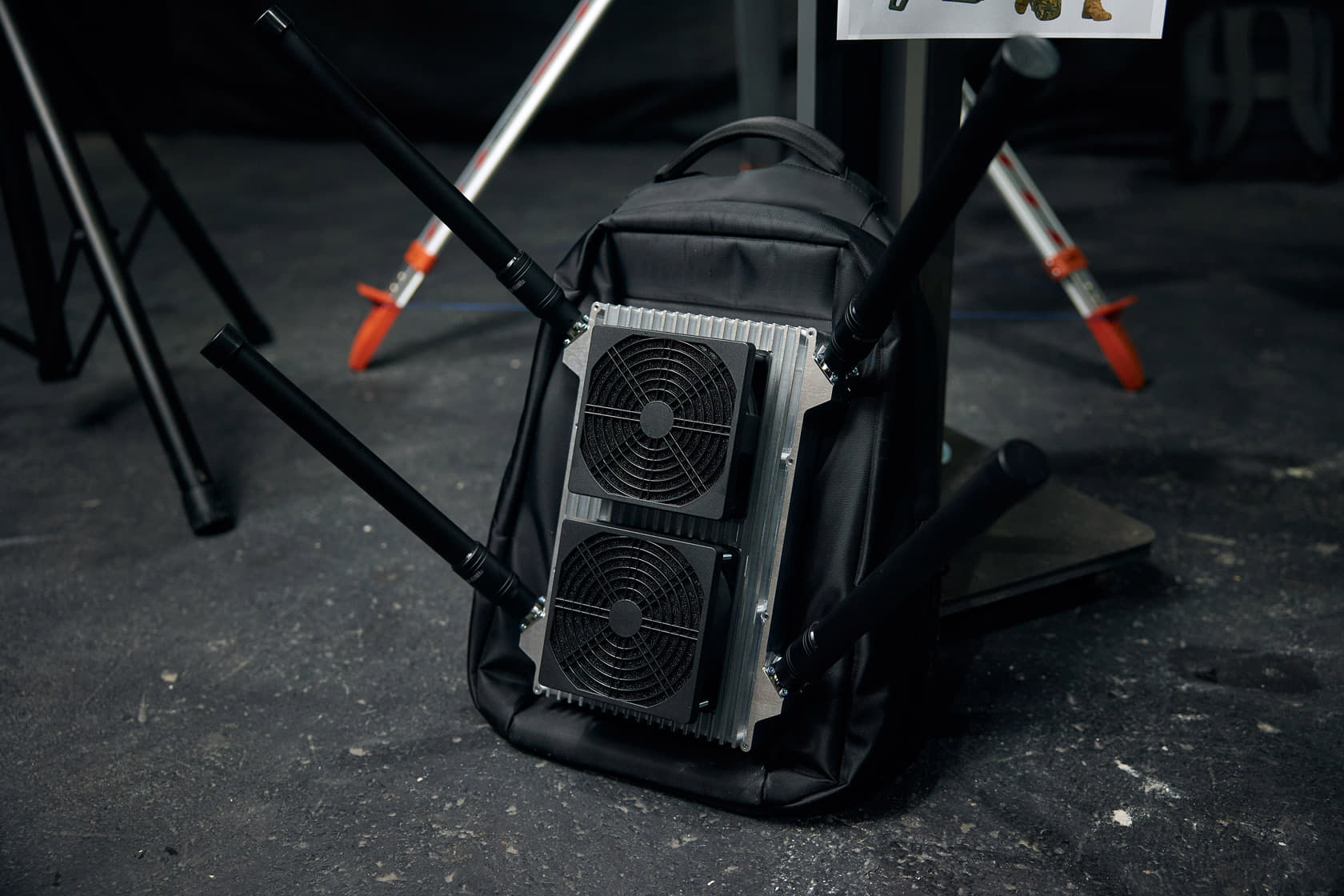There are so many drones that we just can't make it without electronic warfare systems. Why Ukraine is losing to Russia in the technology race

In October 2023, three Ukrainian soldiers were ordered to move a seriously wounded comrade from the left bank of Kherson Oblast to the right bank by boat. On their way back, they were attacked by a Russian drone.
The soldiers were unable to defend themselves. They didn’t have a portable electronic warfare (EW) device that would have neutralised the threat during the crossing.
"All four were killed – the wounded man and the three who were rescuing him," a marine with the alias Orion told Ukrainska Pravda.
This is just one of many stories of soldiers dying because of a lack of electronic defence equipment. Orion says there is a critical shortage of EW devices at the front. And it’s not just the Kherson front.
Drones have become a game changer in the full-scale Russo-Ukrainian war. Sources in the General Staff of the Armed Forces of Ukraine told Ukrainska Pravda that the number of Russian drones in areas where the fighting is heaviest has at least doubled in the last three months alone.
EW systems that can detect and jam aerial targets help counter Russian UAV attacks. Without such protection, Ukrainian troops become targets for Russian strikes.
Ukrainska Pravda explains the reasons for the critical shortage of EW devices at the front, why Ukraine did not scale up production before the full-scale invasion, and how they have evolved since the start of the invasion.
EW evolution. Which EW systems are most common at the front line
Electronic warfare systems can jam enemy communications, reconnoitre potential targets and transmit their coordinates to troops in the field, knock drones off course and force them to land, and counter missile attacks in the rear.
Read more: Colonel Ivan Pavlenko: The war will end, we will win. But the war in cyberspace will never end
EW devices can vary in size, shape and range – from small devices that soldiers can install in trenches or even carry with them, to large radar systems.
The best-known large-scale Ukrainian-made EW systems are Bukovel and Nota, launched in 2014. These systems proved their effectiveness in the early years of the Russo-Ukrainian war, when the main threat at the front was Russian reconnaissance UAVs such as the Orlan.

"The Russians have been using DJI Phantom drones at the front since 2017, followed by DJI Mavics. Their appearance on the battlefield led Ukrainian manufacturers of large EW stations to produce modules to counter these threats. At the time, that was enough," Oleh Donets told Ukrainska Pravda. Donets is head of the electronic warfare/electronic signals intelligence department at Brave1, a government-run cluster for defence tech development.
Since the full-scale Russian invasion started, there has been a huge increase in the intensity with which various types of drones are employed in the battlefield, including massive use of FPVs.
The existing electronic warfare systems are no longer able to cope with them. There is an urgent need to produce compact devices to protect soldiers and military hardware from Russian drones.
During the two years of the full-scale invasion, Ukrainian electronic warfare equipment has evolved from large systems to "pocket-sized devices". Short-range EW systems, commonly referred to as "trench" or portable systems (with an average range of up to 3 km), appeared on the front line and immediately became popular. They are portable and easy to use.

A serviceman with the alias Photon, from the Achilles Attack Drone Battalion of the 92nd Separate Assault Brigade, told Ukrainska Pravda that in the summer of 2023, after EW equipment like this appeared at the front, Russian drones began to reach their targets much less frequently.
Photon says EW systems played a key role during the liberation of Andriivka and Klishchiivka in Donetsk Oblast last year.
"It was hard to liberate these settlements at first because enemy drones kept striking our assault groups. But when portable EW systems appeared, we gained a tactical advantage in assault operations because we were able to defend ourselves," adds Photon.
However, this doesn’t mean large EW systems are no longer relevant – the need for them is still great.
"Trench EW systems are a situational solution to the problem. We have to create large systems that will guarantee soldiers’ safety on the front line, covering them from behind, for example, from the second or third line of defence," Anatolii Khrapchynskyi, Deputy CEO of EW company Piranha Tech, told Ukrainska Pravda.
One of Ukraine's main achievements in the field of electronic warfare is the nationwide Pokrova (Protection) system. It appeared after the start of the full-scale Russian invasion, and as yet little is known about it. But Ukrainska Pravda sources in the military leadership have assured us that it’s a highly effective system.
Pokrova is capable of distorting satellite signals and misleading the navigation devices of Shahed-type attack drones and even cruise missiles. Scaling up tech like this could strengthen Ukraine's air defence, but it wouldn’t replace it. After all, EW systems can knock a Russian target off course, but they can’t destroy it.
Incidentally, large Ukrainian-made EW systems proved their effectiveness during Russia’s massive air attack on Ukraine in January. They helped to disable more than 20 Russian missiles.
A war of technologies. Why does the front line lack EW devices?
There are many reasons for the shortage of Ukrainian EW equipment – both stationary and trench systems – at the front line.
The main one is that EW production in Ukraine only really got going after the start of the full-scale Russian invasion.
Meanwhile the Russian Federation had spent many years developing its EW equipment. Russian stationary EW systems are considered among the most powerful in the world.
Planes flying over European countries sometimes even experience navigation issues due to GPS failures which experts attribute to the influence of Russian EW equipment. Navigation problems have been detected on about 46,000 UK flights since August last year alone.
"The Russians have powerful electronic warfare equipment, both stationary and some very good examples of ‘trench’ devices. Of course, there are some ridiculous and non-functioning systems, but many are effective. Unfortunately, Russia is significantly ahead of Ukraine," Mariia Berlinska, director of the Aerial Reconnaissance Support Centre, told Ukrainska Pravda.
Berlinska believes that Ukraine still does not have a systematic state policy on EW systems production. The state behaves like a passive buyer when it should be supporting manufacturers in every possible way – concluding long-term contracts, helping import components from abroad, and reserving engineers.
Nevertheless, Berlinska says that when it comes to EW production, Ukraine is moving faster than ever.
Expert Anatolii Khrapchynskyi estimates that the production of EW systems in Ukraine has increased by 40-50% since the start of the full-scale Russian invasion.
Oleh Donets told Ukrainska Pravda that the Brave1 platform has brought together more than 50 manufacturers of electronic warfare devices, mostly short-range, in the space of a year. The number of developments now exceeds 100. For comparison, in June 2023 there were only 10.
Of these more than 100 developments, nine EW systems have undergone testing and codification (a procedure for checking a product’s readiness for mass production) at the Ministry of Defence.
All the others still have bureaucratic obstacles to overcome. Although the Cabinet of Ministers (the government of Ukraine) has simplified the process of obtaining approval for use for electronic warfare equipment, manufacturers still have to make huge efforts to get through all the red tape.
Recently, military personnel received 2,000 short-range EW systems from the state. An Ukrainska Pravda source in the Ministry of Defence said that this is just the beginning, and within a few weeks, at least 600 more trench electronic warfare systems will be sent to the front line.
But this is a mere drop in the ocean, because EW devices like these are needed in every trench, in every vehicle, and for every group of troops performing combat missions. In other words, we are talking about hundreds of thousands of systems along the entire line of contact.
At the moment, EW equipment for military personnel is mainly provided by volunteers, or soldiers buy it themselves from the manufacturers, because on the front line, there’s no time to wait for the state bureaucratic mechanism to sort itself out. Everything needs to be done the day before yesterday.
"If you want to stay alive, you’ve got to rely on yourself. So we get the money together for EW equipment ourselves – we don’t wait for it to be given to us," a serviceman who goes by the alias Akhmed told Ukrainska Pravda.
Akhmed has been fighting on the Zaporizhzhia front for nearly two years and has had the importance of EW equipment brought home to him several times. He described one of those times in his conversation with Ukrainska Pravda.
Recently, he was driving in a war zone in a car without EW equipment. He was spotted by a Russian FPV drone, which attempted to attack him.
"I managed to get out and hide in a trench, and the car was hit. At that moment, a second drone was flying towards me to finish me off, but a car equipped with EW drove past and jammed the FPV on approach. So I was able to escape," Akhmed says.
***
Over the last few months, politicians and the public have been discussing the million drones that Ukraine needs to produce this year. This is undoubtedly important because drones are needed to kill Russian military personnel and destroy their equipment.
But it’s also vital to protect Ukrainian soldiers from Russian drone attacks, which are extremely frequent on the front line. And for that, electronic warfare equipment is required. But for some reason, no one is talking about a million EW devices.
Mariia Berlinska says the current level of EW production does not meet even 5% of frontline needs.
"The Russians hardly shell our positions with artillery these days," a serviceman fighting on the Kupiansk front told Ukrainska Pravda on condition of anonymity. "They hunt us with FPV drones 24/7. There are so many of these f**king drones that we just can’t do without electronic warfare devices, and we only have two of them per battalion [usually 300-800 troops – ed.].
Before, the Russians used to use their drones sparingly, with ‘drops’ [of explosives], and they’d only use them on large pieces of hardware or groups of people, but now every soldier is a target that they watch until they’ve killed him," he added.
Not only that, but new upgrades of Russian drones regularly appear at the line of contact. Updated UAVs are difficult to identify and disable because EW equipment is programmed for specific frequency ranges.
"We used to make electronic warfare equipment roughly in the 900 Mhz band. That used to be enough. Now the orcs [the Russians – ed.] are producing drones ranging from 700 to 1000 MHz. So the electronic warfare devices that we made earlier are already ineffective," a source in the General Staff told Ukrainska Pravda.
To respond to this, Ukrainska Pravda sources in the Cabinet of Ministers say, work is currently underway to create a unified system that will be able to collect information about changes in the frequencies of Russian drones so that manufacturers can quickly adjust their EW equipment accordingly.
Electronic warfare equipment requires constant upgrades. This is a frenzied technological race that demands rapid responses to Russian developments. If you stop, you lose.
Нагадуємо, що триває спільний збір "Української правди" та ГО "Український Жіночий Батальйон" на дрони та РЕБи.
🎯Ціль: 5 000 000.00 ₴
🔗Посилання на банку: monobank.ua.
💳Номер картки: 5375 4112 1695 0043
PayPal: womenbattalion@gmail.com
Anhelina Strashkulych, Ukrainska Pravda
Translation: Yelyzaveta Khodatska and Yuliia Kravchenko
Editing: Teresa Pearce